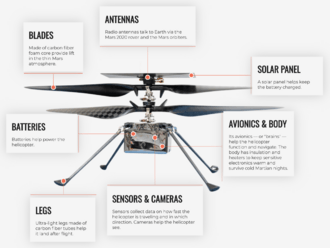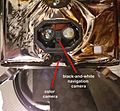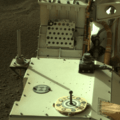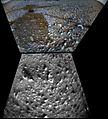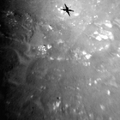Ingenuity (Mars helicopter) facts for kids
Quick facts for kids Ingenuity |
|
|---|---|
| Part of Mars 2020 | |
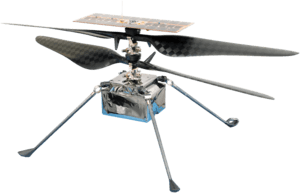 |
|
| Type | UAV helicopter |
| Manufacturer | Jet Propulsion Laboratory |
| Technical details | |
| Dimensions |
|
| Diameter | Rotors: 4 ft (1.2 m) |
| Height | 0.49 m (1 ft 7 in) |
| Landing mass |
|
| Power | 350 watts |
| Flight history | |
| Launch date | 30 July 2020, 11:50:00 UTC |
| Launch site | Cape Canaveral, SLC-41 |
| Landing date | 18 February 2021, 20:55 UTC |
| Landing site | Jezero crater |
| Instruments | |
|
|
 JPL's Mars Helicopter insignia |
|
Ingenuity is a small robotic helicopter designed to fly on Mars. Its main job is to test new technology. It helps scientists learn how to scout interesting places on Mars and find the best paths for future Mars rovers to drive.
This little drone helicopter was sent to Mars as part of NASA's Mars 2020 mission. It landed on February 18, 2021, with the Perseverance rover. Ingenuity was planned to start flying about 30 Martian days (which is about 31 Earth days) after landing.
Ingenuity made history by being the first aircraft to fly on another planet beyond Earth. It was expected to fly up to five times during its 30-day test period. This was mainly to show that the technology works. Each flight was planned to be between 3 and 5 meters (10 to 16 feet) above the ground. In about 90 seconds per flight, it could travel up to 50 meters (164 feet) away and then return.
The helicopter flies by itself using autonomous control during its short flights. However, its flights are carefully planned by controllers at the Jet Propulsion Laboratory (JPL). After each landing, Ingenuity talks directly to the Perseverance rover. If this experiment works well, NASA could use this design for future aerial missions on Mars.
MiMi Aung is the project leader for Ingenuity. Other groups that helped build it include AeroVironment Inc., NASA Ames Research Center, and NASA Langley Research Center.
Contents
How Ingenuity Was Designed
| Rotor speed | 2400 rpm |
| Blade tip speed | <0.7 Mach |
| Operational time | 1 to 5 flights within 30 sols |
| Flight time | Up to 90 seconds per flight |
| Maximum range, flight | 50 m (160 ft) |
| Maximum range, radio | 1,000 m (3,300 ft) |
| Maximum altitude | 5 m (16 ft) |
| Maximum speed |
|
| Battery capacity | 35–40 Wh (130–140 kJ) |
Ingenuity was built by JPL to show that helicopters can fly safely on Mars. It aims to provide better maps and guidance for future missions. This helps scientists plan travel routes and avoid dangers for rovers. It also helps find interesting spots for the rover to explore.
The helicopter can take pictures from above that are much clearer than images from orbit. It can also photograph areas that the Perseverance rover's cameras might not be able to see. Scientists believe that this kind of scouting could help future rovers travel up to three times farther each Martian day.
Ingenuity uses two coaxial rotors that spin in opposite directions. These rotors are about 1.2 meters (4 feet) across. It has a high-resolution camera that looks downwards. This camera helps with navigation, landing, and surveying the ground. It also has a communication system to send data back to the Perseverance rover.
Even though it's an aircraft, Ingenuity was built to be as tough as a spacecraft. This helps it survive the strong forces and shaking during launch. It also has special systems that can handle radiation and the very cold temperatures on Mars. Mars' magnetic field is not steady, so Ingenuity cannot use a compass. Instead, it uses a solar tracker camera and a special navigation system. It also uses gyros, visual odometry, tilt sensors, an altimeter, and hazard detectors to navigate.
The helicopter uses solar panels to charge its batteries. It has six Sony Li-ion cells that can store 35 to 40 watt-hours of energy.
Ingenuity uses a Qualcomm Snapdragon 801 computer chip with a Linux operating system. This chip helps control the navigation using images from its camera. The Qualcomm chip is connected to two smaller computer units that handle the flight controls. It also carries an IMU and a Garmin LIDAR Lite v3 laser altimeter.
It communicates with the rover using a radio link. This link uses low-power Zigbee communication. It can send data at 250 kilobits per second over distances up to 1,000 meters (3,280 feet).
The helicopter was attached to the bottom of the Perseverance rover. It was deployed to the Martian surface between 60 and 90 Martian days after the rover landed. This was between April 19 and May 19, 2021. After Ingenuity was deployed, the rover drove about 100 meters (328 feet) away so the helicopter could begin its flights.
Testing Ingenuity
In 2019, early versions of Ingenuity were tested on Earth. Scientists created conditions that were similar to Mars. They used a large vacuum chamber to copy Mars' very thin atmosphere. This chamber was filled with carbon dioxide at about 0.60% of Earth's air pressure at sea level. This is like flying a helicopter at 34,000 meters (111,500 feet) high in Earth's atmosphere!
To simulate Mars' weaker gravity, which is only about 38% of Earth's, a line pulled the helicopter upwards during flight tests. This offset 62% of Earth's gravity.
Future Mars Helicopters
The success of Ingenuity could lead to even more advanced aircraft for exploring Mars and other planets with atmospheres. The next generation of Mars helicopters might be heavier, weighing between 5 and 15 kg (11 to 33 pounds). They could carry more science tools, weighing between 0.5 and 1.5 kg (1.1 to 3.3 pounds).
These future aircraft might be able to talk directly to orbiters around Mars. They could explore special areas where water ice or salty water might exist, which could be places where Earth microbes could survive. Mars helicopters might also be used to quickly pick up small samples and bring them back to a vehicle that would launch them to Earth.
How Ingenuity Was Developed
NASA's JPL and AeroVironment first shared the idea for a scout helicopter to go with a rover in 2014. By mid-2016, they asked for US$15 million to keep developing the helicopter. In December 2017, engineering models were tested in a simulated Martian atmosphere. Models were also tested in the Arctic.
In March 2018, the United States government provided US$23 million for the helicopter for one year. On May 11, 2018, it was announced that the helicopter could be ready in time for the Mars 2020 mission.
The helicopter went through many tests to make sure it could fly and survive in space. It was then attached to the bottom of the Perseverance rover in August 2019. Ingenuity weighs just under 1.8 kg (4 pounds). JPL planned for it to make 5 flights on Mars.
The helicopter was named by Vaneeza Ruppani, an 11th-grade student from Tuscaloosa County High School in Northport, Alabama. She submitted an essay to NASA's "Name the Rover" contest. NASA spent about US$80 million to build Ingenuity and about US$5 million to operate it.
Images for kids
-
Ingenuity upper swashplate assembly: A – Rotor blade; B – Pitch link; C – Servo; D – Swashplate
See also
 In Spanish: Mars Helicopter Ingenuity para niños
In Spanish: Mars Helicopter Ingenuity para niños


